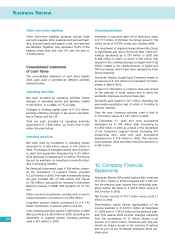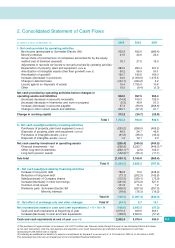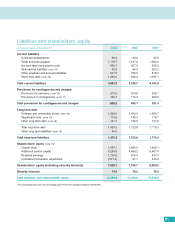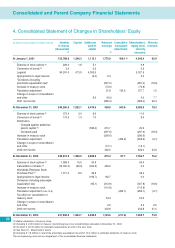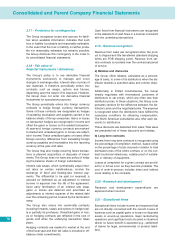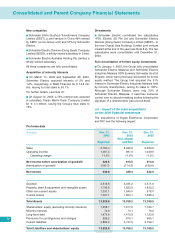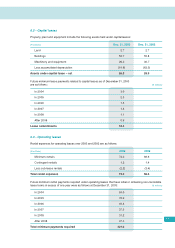APC 2003 Annual Report Download - page 71
Download and view the complete annual report
Please find page 71 of the 2003 APC annual report below. You can navigate through the pages in the report by either clicking on the pages listed below, or by using the keyword search tool below to find specific information within the annual report.
The Group’s accounts receivable are generated from
sales to customers who are economically and geo-
graphically widely dispersed. Consequently, the
Group believes that there is no significant concentra-
tion of credit risk.
The main North American subsidiary of the Group,
Square D Company, optimizes its cash and working
capital management by selling receivables to finan-
cial establishments. In keeping with French GAAP,
these receivables are deconsolidated.
2.13 - Deferred taxes
Deferred taxes, corresponding to temporary differ-
ences between the tax basis and reporting basis of
consolidated assets and liabilities, are recorded
using the liability method. Deferred tax assets are
recognized when it is probable that they will be real-
ized at a reasonably determinable date.
Future tax benefits arising from the utilization of tax
loss carryforwards (including amounts available for
carryforward without time limit) are recognized only
when they can reasonably be expected to be real-
ized.
Deferred tax assets and liabilities are discounted
where significant and when reversals can be reliably
scheduled.
2.14 - Cash and cash equivalents
Cash and cash equivalents as presented in the bal-
ance sheets consist of cash, bank accounts, treasury
shares to be used to cover stock options and pro-
grams to stabilize the share price, short-term
deposits and other liquid marketable securities.
Substantially all marketable securities represent
short-term instruments such as commercial paper,
mutual funds and equivalents. They are valued at the
lower of cost or market. In the case of bonds and
other debt instruments, cost includes accrued inter-
est.
2.15 - Treasury stock
Schneider Electric shares held by the parent compa-
ny or by companies fully consolidated are either:
■Recorded as cash and cash equivalents in the
accompanying consolidated balance sheets, where
such treasury stock is explicitly assigned to stock
option plans for the benefit of employees or is intend-
ed to stabilize the stock price; or
■Deducted from consolidated shareholders’ equity
in all other situations.
The accounting treatment of the gain or losses
resulting from the sale of treasury stock depends on
the intended purpose of holding the stock.
Gains or losses on sales of securities classified as
cash and cash equivalents are recorded in the
accompanying consolidated statement of income.
Other gains and losses are deducted from consoli-
dated shareholders’ equity, net of tax.
2.16 - Pensions and other
post-retirement benefit obligations
Depending on local practices and laws, the Group’s
subsidiaries participate in pension, insurance and
statutory retirement bonus plans. Benefits paid under
these plans depend on such factors as seniority,
compensation levels and payments into mandatory
retirement programs. The method used to value
retirement benefits takes into account future com-
pensation levels.
Two methods are used to calculate the Group’s lia-
bility for statutory retirement benefits:
■Accruals - the accrual is calculated for all eligible
employees based on the determination of the pre-
sent value of the future liability using a rate reviewed
each year and based on market conditions.
■External funding under an insured plan - in this
specific case, an amount is reserved to cover any
deficit between the fair value of plan assets and the
present value of the estimated future liability.
The Group’s policy concerning the recognition of
changes in accruals for statutory retirement bonuses
is as follows:
■Changes in the present value of the liability and
changes in certain actuarial assumptions regarding
demographics (e.g., length of service, number of eli-
gible employees, etc.) are recognized in full in the
statement of income when they arise.
■Changes resulting from periodic changes in actu-
arial assumptions regarding general financial and
business conditions (i.e., changes in the discount
rate, annual salary increases and return on assets)
are deferred and recognized over the remaining ser-
vice life of the employees concerned, if they exceed
10% of the greater of the projected benefit obliga-
tions or market-related value of plan assets.
The Group also provides supplemental retirement
benefits to a limited number of active and retired
senior executives. These defined benefit obligations
are accrued for based on the contractual terms of the
agreements, which provide guaranteed minimum
payment terms beyond the general retirement bene-
fit scheme.
Accruals are booked to cover the cost of providing
healthcare benefits for certain retired employees. 69



